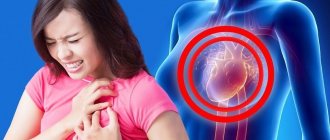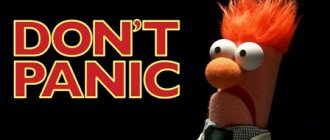There are several ways to deal with panic attacks. All of them can be divided into three types:
- Medicines;
- Psychological (psychotherapeutic) techniques and techniques;
- Other techniques typically used in specialized clinics (physiotherapy, biofeedback therapy, physical therapy, reflexology).
Below we will describe in detail the first group - medications for panic attacks.
.
Like any medicine, drugs for panic attacks must be prescribed by a clinic doctor, who, before prescribing them, clarifies the patient’s condition and determines all indications and contraindications!
All medications that help with panic attacks are divided into two groups:
- Quick aid equipment (“ambulance”). Can be used once. Allows you to prevent or relieve a panic attack.
- Medicines for continuous use (preventive). Taking these pills helps prevent the development of a panic attack.
Eltacin®: description of the drug
Eltacin® is a combination drug that acts as an antioxidant and antihypoxant (i.e., it improves the excretion of oxygen and increases the body's resistance to oxygen deficiency). It contains three active components: glycine, cysteine and glutamate. This unique combination of amino acids has a triple effect: it regulates metabolism, increases the stability of the central nervous system, and provides maximum protection for the cardiovascular system.
Amino acid glycine
is a regulator of metabolism and a stabilizer of mental processes. Thanks to it, metabolic reactions in brain tissue are accelerated and psycho-emotional stress is reduced.
Cysteine
, which is part of Eltacin®, is necessary to maintain optimal glutamate concentrations and normal functioning of muscle tissue. By activating metabolic and recovery processes, it increases resistance to stress and infections, accelerates the elimination of toxic products and fills the body with additional energy.
Glutamate (glutamic acid)
is the main “fuel” for the brain. This organic compound prevents the development of oxygen starvation, binds and removes ammonia from the body, takes part in the synthesis of ATP and the transfer of potassium ions.
The 3 active components that make up Eltacin® form the tripeptide glutathione. This is the most powerful antioxidant known today, acting directly on the cause of vegetative-vascular dystonia.
In what situations will Eltacin® be useful to you?
The main indications for use of the drug are autonomic dysfunction. Eltacin® is also recommended for increased physical activity to avoid complications for the cardiovascular system, including for professional athletes, as well as for heart failure as part of complex treatment.
The quality of life of people with chronic heart failure is determined by how rationally they can distribute their own physical resources. Eltacin® improves the contractility of the myocardium and reduces its need for oxygen, so even with ineffective blood circulation, heart cells do not suffer from a lack of energy. Regular use of Eltacin® prolongs active life in chronic heart failure, reduces the severity of symptoms, and in acute heart failure improves the prognosis and helps to recover faster. Used as a cardioprotector.
If you decide to lose weight in the gym or go jogging, but are not confident in your physical endurance, start a course of Eltacin® 2 weeks before training. This will protect your heart from unnecessary stress and prevent all possible complications that you risk getting before you begin to get into the desired shape.
Pharmacological properties
The drug Eltacin® has the following effects:
- reduces the concentration of oxidation products;
- prevents the development of oxygen starvation;
- increases physical and mental activity;
- improves nutrition of the heart muscle;
- normalizes the psycho-emotional background;
- improves the condition of the autonomic nervous system;
- reduces feelings of anxiety and aggression;
- restores the level of social adaptation;
- reduces the toxic effect of substances that disrupt the functioning of the central nervous system.
Indications for use
In accordance with the instructions for use, Eltacin® is approved for use in the following situations:
- in case of disruption of the autonomic nervous system in adults and children over 12 years of age;
- with prolonged stress, psycho-emotional stress;
- nervous disorders (emotional instability, consequences of traumatic brain injuries, neurogenic infections, sleep disorders, increased nervous excitability);
- chronic physical / mental exhaustion in children 12–15 years old.
Medications to take regularly for panic attacks
Constant use of pharmacotherapy allows you to stabilize the biochemical and physiological processes in the nervous system that are responsible for the development of panic attacks.
Basically, such drugs act on specific receptors in the brain and restore the normal activity of neurotransmitters: dopamine, serotonin, norepinephrine, adrenaline, acetylcholine and others.
Antidepressants
Mainly affects serotonin receptors of the nervous system. They are used in courses of several months (from three to more than a year). The most “popular” and common antidepressants for preventing panic attacks:
- Escitalopram (cipralex, elicea);
- Paroxetine (Paxil);
- Amitriptyline;
- Sertraline (Zoloft);
- Fluvoxamine (fevarin).
Neuroleptics
They act predominantly on dopamine receptors in the brain. Prescribed in cases where panic attacks are a manifestation of an endogenous disease. Like antidepressants, they are taken for a long time from several months to several years.
Contrary to popular belief among people with anxiety disorders, they do not cause addiction. The most commonly used antipsychotics for long-term treatment of panic attacks are:
- Thioridazine (Sonapax);
- Sulpiride (eglonil);
- Quetiapine (Seroquel);
- Risperidone (rispolept);
- Flupenthixol (fluanxol).
Normotimic drugs
Their mechanism of action is the normalization of the ratio of excitation and inhibition processes in the brain. Most effective for panic attacks due to encephalopathy, consequences of traumatic brain injuries, strokes, and hypoxia.
The most common representatives of normotimics:
- valproic acid (Depakine Chrono),
- lamotrigine (Lamictal),
- carbamazepine (finlepsin).
To summarize, it can be noted that among the above-listed medications there are several drugs with a universal effect: they are suitable both for a single dose to quickly relieve a panic attack, and for long-term use. These are the antidepressant amitriptyline and the antipsychotics quetiapine, thioridazine and sulpiride.
This material is for informational purposes only. Under no circumstances should you use the medications described above for panic attacks on your own. Any use of the drug should only be as prescribed by a doctor! Don't self-medicate!
How to take Eltacin® in the treatment of vegetative-vascular dystonia
Eltacin®, part of the group of over-the-counter drugs, is available in the form of lozenges. According to the indications for use, this drug is allowed to be used in the treatment of vegetative-vascular dystonia.
For adults with VSD, Eltacin® is recommended to take 1 tablet 3 times a day, for children - 1 tablet 2 times a day, regardless of meals. How long the course of treatment will last is determined by the attending physician. In accordance with the instructions, the duration of the course is 1–3 months for adults and 2–3 weeks for children.
Taking Eltacin® is contraindicated for patients under 12 years of age and for people with individual intolerance to the components of the drug.
To date, Eltacin® is recognized as the only specialized drug with general action that can combat the manifestations of VSD.
Quick help for a panic attack
Benzodiazepine tranquilizers
The most effective and fastest-acting medications for panic attacks are a group of benzodiazepine tranquilizers
. These include:
- alprazolam (Xanax),
- clonazepam,
- diazepam (Relanium),
- bromodihydrochlorophenylbenzodiazepine (phenazepam).
These are potent drugs and therefore are not commercially available. They can be purchased using special prescriptions, which can only be prescribed by certified doctors in licensed clinics.
The action of benzodiazepine tranquilizers provides rapid relief of anxiety, vegetative manifestations (rapid pulse and breathing, sweating, trembling, chills and heat waves, dizziness, etc.), normalization of sleep and appetite.
Since the basis of any panic attack is anxiety and excessive activation of brain structures responsible for the protective anxiety reflex, then, regardless of the causes, mechanism of development and manifestation of panic, tranquilizers always have a quick effect. They will either prevent the development of a panic attack, or (if it has already begun) stop it.
Benzodiazepine tranquilizers are used once - as an ambulance, or in short courses (usually no more than a week). With long-term use, dependence is formed, one of the manifestations of which will be “increasing tolerance” - the need to increase the dose to achieve an effect.
These drugs are often used in tablet form. As a rule, taking one tranquilizer tablet ensures the development of a therapeutic effect in 20-40 minutes.
Some of these drugs (diazepam, bromodihydrochlorophenylbenzodiazepine) exist in the form of a solution, which allows them to be used as injections intramuscularly or intravenously, in which case the effect occurs very quickly - from a few seconds to several minutes.
Advantages of benzodiazepine tranquilizers: pronounced anti-anxiety effect, rapid onset of action, well tolerated.
Disadvantages: difficult to purchase (you need a doctor's prescription, a special prescription form), a common side effect is drowsiness and lethargy; if taken regularly, they can cause physical and mental dependence.
Non-benzodiazepine tranquilizers
The next group is non-benzodiazepine tranquilizers
. They are distinguished from the first group by a different chemical structure. The most common representatives:
- hydroxyzine (atarax),
- mebicar,
- etifoxine,
- meprobamate.
In terms of potency, they are inferior to the drugs of the previous group. But they also have their advantages: they are well tolerated, do not cause drowsiness, do not develop dependence, and are easier to purchase in pharmacies (no special prescriptions are needed).
The most common remedy in this group is ATARAX
. They can be used once to prevent or relieve a panic attack. It is also used for long-term use, which can prevent the recurrence of a panic attack.
Thus, tranquilizers
- the most common and popular group of pills for panic attacks. It has been noticed that many people who have long gotten rid of panic attacks, but remember these unpleasant anxiety states, try to carry a tranquilizer pill with them “just in case.”
Neuroleptics
Neuroleptics with sedative action. This is the next group of drugs that have a sedative effect and can relieve a panic attack. The most common tablets are:
- Thioridazine (Sonapax);
- Periciazine (neuleptil);
- Chlorprothixene (Truxal);
- Quetiapine (Seroquel);
- Alimemazine (teraligen);
- Sulpiride (eglonil).
The general sedative effect of these drugs allows, when taken continuously, to prevent the development of panic attacks, and when taken once, to relieve a panic attack.
The disadvantage of this group of drugs is that, in addition to anxiety, other emotional reactions (joy, surprise, delight, pleasure, curiosity, melancholy, etc.) can be suppressed.
Antidepressants with sedative effects
Despite the fact that antidepressants are the most prescribed pills in the complex treatment of panic attacks, they can also be used as an “ambulance” - once to stop a panic attack. For this purpose the following are most often used:
- Amitriptyline;
- Clomipramine (Anafranil);
- Mianserin (lerivon)
Unlike antipsychotics and tranquilizers, the effect of antidepressants does not develop as quickly, but is longer lasting.
Other drugs for quick relief of an attack
- aminophenylbutyric acid (phenibut),
- glycine,
- ethyl alcohol (alcohol),
- valocordin or corvalol (and their analogues),
- beta-blockers (anaprilin, atenolol),
- alpha-blockers (clinidine), etc.










